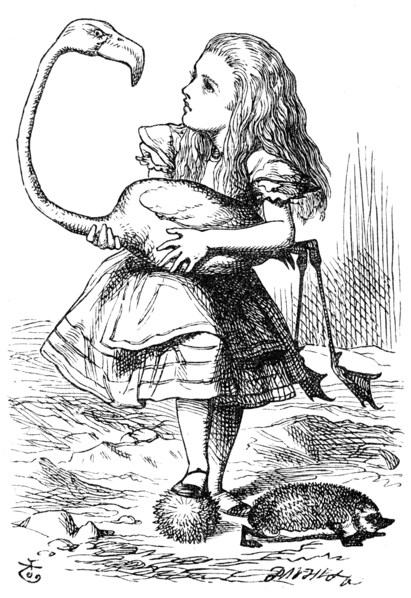From Richard Jenkyns (“What Alice did,” Prospect, 21st September 2011):
Literary academics, too, have delighted in constantly reinterpreting Carroll’s works. To William Empson, 70 years after Alice in Wonderland’s publication, a Freudian interpretation of Alice was so obvious that it was hardly worth mentioning: she enters Wonderland in the foetal position, the pool of tears represents the amniotic fluid, and so on. In 1995 Morton Cohen, author of what is in many ways an excellent biography of Carroll, suggested that the books are a metaphor for the plight of an upper-class child, a criticism of the social shibboleths of the age, and perhaps a form of autobiography, with Alice being the author in disguise. More recently, a Princeton professor has claimed that Alice is at once Dodgson’s dream-child, Dodgson himself, a sex-kitten who teases the male member, and Jesus Christ (“the similarity… seems inescapable”). Curiouser and curiouser. Other people have claimed that Alice is an allegory of Darwinism, or that it is about toilet training or the desire for coitus. The reason why these interpretations are possible at all is the reason why they all ultimately miss the point. The point is that Alice is dreaming. Hierophants from Artemidorus to Freud have claimed to possess the key to unlock the meaning of dreams, but we still understand very little about them. Twentieth-century fiction contains plenty of dreams, but most of them feel contrived, calculated to fit some theory (most often Freudian theory).
Over the years, we have heard all the other literary deadweight explanations (of why some people, like Oxford mathematician Charles Dodgson could write and other people couldn’t and can’t). Presumably stuff like this is meant:
It is interesting to note that the time period in which Carroll wrote and published Alice was the same time at which Charles Darwin was writing and publishing his historic book The Origin of Species in which he puts forth the now universally known ideas of evolution and survival of the fittest. Darwin developed these ideas while he served as naturalist on the ship the Beagle from 1831-1836. During this time, he studied wildlife on the Galapagos Islands, and was amazed by the great diversity of life. He was especially interested in the birds of the island, which had highly adapted beaks that fit their particular eating habits and lifestyle. (Coincidentally, in one of the first scenes in Wonderland, Alice arrives on shore with a group of different…
Another author thinks it significant that Alice meets a Dodo. (She also meets a pack of animated Playing Cards, a caterpillar smoking a hookah, and a cat who can become invisible at will. All well known to evolutionary biologists, of course.)
Literary deadweight explanations of why some people can write and others can’t: A perennial feature of lit studies. The subject is a genuine mystery, in one of the proper senses of the term: Almost all explanation, apart from crackpot theories, ends up focusing on technique. But as writing instructors know, that part of the craft is well known both to stellar and to mediocre writers, and is easy to teach to the co-operative student. The part that lies just beyond recedes with the analysis, only to appear again when least expected. Described sometimes, not explained. Alice was written due to the nagging of one little girl, for example, but no general theory of writing for children as a result of listening to them nag obviously follows.
